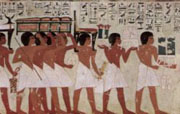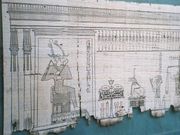
Subjects carrying Ramose, from the tomb of Ramose.
| This is a work in progress: lots of writing, formatting, revising, proofing left to do! — David McMurrey |

If you went through the chapter on actions and verbs first before coming to this chapter, you know that sentences can blur, hide, or even omit the real characters and real actions that they contain. This is one of the most important contributions that Joseph M. Williams (among others) gave us in his Style: Ten Lessons in Clarity and Grace.
In this chapter, you'll see how, in some sentences, the true character—actor—of a sentence is not stated in the grammatical subject of that sentence or may even be absent from the sentence altogether. If you read the actions-and-verbs chapter, you know the same thing can happen with the true "action" of a sentence and the grammatical verb. These separations can be caused by constructions like nominalizations (covered in this chapter) and passive voice. The problem with these separations is that they force readers to do some extra mental processing in order to understand the sentences in which they occur. And, they often cause sentences to be wordy and awkward.
Character-subject separation:Sentences of this type are one of the biggest problems in professional, business, governmental, and technical writing. And, for some people, the distinction between sentence "characters" and "subjects"—and their separation—are difficult to understand. Take your time going through this chapter.
In this chapter, you'll practice identifying the actual, "true" character in sentences when it is not also operating as the grammatical subject. We'll call these situations character-subject separations. You'll then practice revising these sentences so that the true character is in the grammatical-subject slot.
As Joseph M. Williams in Style: Ten Lessons in Clarity and Grace shows, grammatical subjects and characters can be separate from each other in sentences. Here's an example:
Character-subject separation: Complaints by freshmen about the cafeteria food have been frequent.

Freshmen may be complaining about dorm food, but the sentence does not have freshmen in the grammatical-subject slot, even though it is the true character of the sentence. Similarly, the verb complain is the true action in the sentence, but it is not in the grammatical-verb slot. Here is the revision:
Revision: Freshmen have frequently complained about the cafeteria food.
As you can see from the following table, the revision changes the subject from Complaints to Freshmen and the verb from the limp have been to the active have complained:
| Version | Subject | Verb |
| Original | Complaints | have been |
| Revision | Freshmen | have complained |
When a verb (complain) has been converted into a noun (complaint), think of the resulting noun as a nominalization. Nominalization simply means that something has been "noun-ified." A nominalization is the "noun-ification" of a verb. In the preceding example, Complaints is the nominalization.
Nominalization:While the preceding example may be wordy, awkward and roundabout, nominalizations and character-subject separations are not necessarily wrong. Consider what is going on in a sentence like this:
Character-subject separation: In the voting in this year's election, the economy was clearly the major issue.
In this example, the grammatical subject election is not the true character of the sentence—voters are. But we know that. It's obvious. This sentence wants to emphasize economy. This revision is wordy and lacks the power of the original:
Ineffective revision: In this year's election, voters clearly indicated that the economy was the major issue.
Nominalizations can also occur in sentences where the action is not operating in the grammatical-verb slot. This type is covered in actions and verbs: actions missing in action.
To understand the rest of this chapter, you should be able to identify most of the variations of grammatical subjects and verbs that the English language can throw at you. If you're not sure whether they can identify subjects and verbs, see additional resources.

If you understand the distinction between characters and subjects of sentences, consider the following examples. In these examples, the true character gets progressively harder to identify; the sentences get progressively harder to revise. As you read this next section, cover up the revisions and see if you can mentally work them out yourself.
Character-subject separation: The amendment was passed through the cooperation of the president and Congress.
Obviously, the president and Congress are the real characters—the true actors—of this sentence, but they are not in the grammatical subject slot—amendment is. If you move the president and Congress to the beginning of sentence, it should be obvious that cooperation should be converted into the main verb. Because cooperation can so readily be changed to the verb cooperated, cooperation is a nominalization. As you can see in the revision, the real characters doing the acting are shifted into the grammatical-subject slot, and cooperation is converted to a verb and shifted into the grammatical-verb slot:
Character:Revision: The president and Congress cooperated to pass the amendment.
But consider this sentence:
Character-subject separation: Until well into the twentieth century, the judgment as to whether same-sex twins were identical or fraternal was largely based on appearance.
Wait a minute! Is it really necessary to do this to readers? Most readers will need extra mental processing time to understand this sentence. True, not a lot of time—but unnecessarily piling on lots of this style of writing can frustrate readers and ruin an entire communication. There are any number of ways to rework this sentence:
Revision:
Until well into the twentieth century, people judged same-sex twins to be identical or fraternal largely on the basis of appearance.
Revision:
Until well into the twentieth century, we judged same-sex twins to be identical or fraternal largely on the basis of appearance.
Revision:
Until well into the twentieth century, same-sex twins were judged to be identical or fraternal largely on the basis of appearance.
This last example uses the dreaded passive voice. The passive voice is an important tool in our language and one not to be avoided. You can spot a passive-voice construction when you can successfully apply the by-whom or by-what question. For example, were judged by whom or by what? Well, by people, doctors. But the who (who's doing the judging) is unimportant, which makes the passive voice here perfectly acceptable. Even so, same-sex twins is not the real character—the real actor—of this sentence. The twins are not doing the judging. But this separation would not cause most readers much trouble.
Grammatical subject:Here are lots of additional examples, arranged from simple to difficult. Study as many of these examples as you can so that you can revise character-subject separations on your own.
This one is easy:
Character-subject separation: The invention of writing toward the end of the fourth millennium B.C. is credited to the Sumerians.
In the revision, Sumerians is shifted to the subject slot:
Revision: Sumerians invented writing toward the end of the fourth millennium B.C.
However, if the primary focus of the discussion in which this sentence occurs is writing, leave this sentence as it is.

Here's another easy one:
Character-subject separation: The first creation of "word writing" was by the Sumerians in 3100 B.C.
Here, the nominalization creation is converted to the verb created; Sumerians is shifted to the subject slot:
Revision: The Sumerians in 3100 B.C. created "word writing."
You almost never want to have a sentence with a be verb followed by a preposition—in this case, was by.
This one may be a bit harder:
Character-subject separation: The adaptation of the papyrus roll for books by the Greeks occurred sometime before the fourth century B.C., the date of the earliest surviving fragments of Greek books.
Obviously, the Greeks did the adaptation:
Revision: The Greeks adapted the papyrus roll for books sometime before the fourth century B.C., the date of the earliest surviving fragments of Greek books.
Here's another example:
Character-subject separation: Recognition would have been immediate for any Egyptian of the twentieth century B.C. who saw a Greek or Roman papyrus-roll book of the time of Christ.
In this revision, the nominalization Recognition is converted to the verb would have recognized, and the true character Egyptian is shifted to the subject slot.
Revision: Any Egyptian of the twentieth century B.C. would have recognized a Greek or Roman papyrus-roll book from the time of Christ.
Consider this one—it has two nominalizations and two missing characters:
Character-subject separation: In the estimation of scientists, the extinction of as many as four and a half million species (or 90 percent of the whole) occurred at the end of the Paleozoic era.
In this revision, the nominalizations estimation and extinction are converted to the verbs estimate and became (extinct), and the true characters scientists and species are shifted to the subject slots of the independent and dependent clauses.
Revision: Scientists estimate that as many as four and a half million species (or 90 percent of the whole) became extinct at the end of the Paleozoic era.
Here's another sentence with nominalizations—two this time:
Character-subject separation: The evolution of new species occurred as a result of their escape of their parental species from extinction by virtue of the geographic isolation of the latter.
The nominalization evolution is converted to the verb evolved; the nominalization escape (yes, it's a noun in the original), into the verb escaped. The phrases new species and parental species are shifted into their rightful subject slots.
Revision: New species evolved because their parental species escaped extinction by virtue of their geographic isolation.
For this one, in addition to restoring the character to its rightful place as subject and converting a nominalization to a verb, you have to do some wordsmithing as well:
Character-subject separation: The major change throughout the entire history of the book has been in the continuous increase in speed of production.
In this one, you have many possibilities: change, increase, and production are all nominalizations and candidates for conversion to verbs. The following revision converts increase to the verb has increased. book is shifted to the subject slot, even though it may seem to attribute human actions to an inanimate object.
Revision: Throughout its entire history, the book has continuously increased in terms of the speed of its production.

This next example contains a word that may be unfamiliar, codex. A codex is a book in the format used for modern books, with separate pages normally bound together and given a cover. Some historians believe it was invented by the Romans in the first century AD.
Character-subject separation: The need to find information more rapidly than is possible in a papyrus-roll-form book initiated the development of the Roman codex in the second century A.D.
Here, the nouns need and development are the candidates for conversion to verbs. In the revision, you can see that they have been converted to needed and to developed. Romans and they are shifted to (actually, they are created for) the subject slots of the independent and dependent clauses.
Revision: The Romans developed the codex in the second century A.D. because they needed to find information more rapidly than possible in a papyrus-roll-form book.
And, yes, another one:
Character-subject separation: About 3500 B.C., the Sumerians' need to record accounts motivated their invention of an elementary protowriting for marking on spherical or oblong hollow clay balls that contained tokens.
In the revision, Sumerians is shifted to the subject slot; the nominalization invention is converted to the verb invented. Notice that the sentence contains a second nominalization, whose conversion is shown in brackets.
Revision: About 3500 B.C., the Sumerians invented an elementary protowriting for marking on spherical or oblong hollow clay balls as a method of recording accounts. [or because they needed a method of recording accounts.]
Sometimes, the true character of a sentence containing a nominalization in the subject slot may be missing altogether. However, it should be obvious from the context. In this one, it is our old friends the Sumerians.
Character-subject separation: Production of books in cuneiform script on clay tablets that were either sun dried or kiln baked persisted until the first century A.D.
Notice in a number of the revisions here, the time information is shifted from the end to the beginning of the sentence. For some reason that creates better clarity.
Revision: Until the first century A.D., Sumerians produced books in cuneiform script on clay tablets that were either sun dried or kiln baked.
If you find the passive-voice phrase were either sun dried or kiln baked is bit unclear, convert that part of the sentence to active voice:
Revision: Until the first century A.D., Sumerians produced books in cuneiform script on clay tablets that they either sun dried or kiln baked.

Here is another example in which you can transform two nominalizations:
Character-subject separation: The need both for administrative and religious records shaped the development of the papyrus-roll book.
And here are the two revisions, the second of which converts both nominalizations:
Revision: The papyrus-roll book developed as a result of need both for administrative and religious records.
Revision: The papyrus-roll book developed because people needed to keep both administrative and religious records.
This next one has a different wrinkle: infinitives rather than nominalizations are the problem. Also, the people doing the sewing, the Romans, are missing:
Character-subject separation: For readier access, the technique was to sew together gatherings of folded sheets of papyrus and then to sew the outermost gatherings to wood, papyrus, or leather covers.
In this example, technique just doesn't work—toss it outta there! Shift Romans to the subject slot and, in this case, shift the infinitives to sew to the main verb slots:
Revision: For readier access, the Romans sewed together gatherings of folded sheets of papyrus and then sewed the outermost gatherings to wood, papyrus, or leather covers.
This one may be a bit difficult:
Character-subject separation: In the last third of the twentieth century, the metamorphosis of the book composed of bound, inked and folded sheets into a screen display on an electronic machine began.
What a mess this sentence is! It takes 18 words to get from the subject to the verb! Obviously, metamorphosis is subject of this sentence but not the character. Who or what is? It certainly could be book:
Revision: In the last third of the twentieth century, the book composed of bound, inked and folded sheets metamorphosed into a screen display on an electronic machine.
In this revision, the nominalization metamorphosis is converted to the main verb of the sentence. You could wordsmith the sentence some more: for some of us, metamorphosed is a rather awkward verb; and it would be clearer to rephrase using the from...to construction:
Revision: In the last third of the twentieth century, the book changed from a physical object composed of bound, inked and folded sheets into a screen display on an electronic machine.
Had enough? If you are confident with what you've studied in this chapter, use these two sets of exercises to test yourself:

If you yourself can intentionally write sentences where grammatical subjects and characters are not one in the same, you’ve mastered this important writing concept. Study how the following perfectly decent sentences have been destroyed by separating grammatical subject and character:
Character-subject unified: Sometime around 3100 B.C., King Narmer united the kingdoms of Upper and Lower Egypt.
Let's ruin this sentence!
Character-subject separated: Sometime around 3100 B.C., the joining of the kingdoms of Upper and Lower Egypt by King Narmer occurred.
Fiendish, huh? Now, this one:
Character-subject unified: For its nourishment, ancient Egypt depended on the Nile, stretching for the 750 miles from the first cataract at Aswan north to the Mediterranean Sea.
Attack!
Character-subject separated: The nourishment of ancient Egypt was dependent on the Nile which stretched the 750 miles from the first cataract at Aswan north to the Mediterranean Sea.
And another?
Character-subject unified: Two thousand years later, about 700 B.C., an even more abbreviated hieratic script, called demotic, came into being.
If you haven't noticed, the trick to destroying these sentences involves finding a verb, changing it to a noun, moving it into the subject slot, and rephrasing the rest of the sentence accordingly. In this example, however, we grab a lifeless word out of the air and make it the subject:
Character-subject separated: Two thousand years later, about 700 B.C., the existence of an even more abbreviated hieratic script, called demotic, came into being.
Here's one in which we can score bonus points by creating two nominalizations—two character-subject separations:
Character-subject unified: Egyptian scribes applied red ink, known as rubrication, to papyrus documents to aid users in locating information therein.
Now, instead of scribes and users, we now have the skillful nominalizations application and location:
Character-subject separated: The application of red ink, known as rubrication, was used by Egyptian scribes in papyrus documents to aid in the location of information therein.
If you are confident that you can destroy sentences by separating grammatical subjects and characters and by creating nominalizations, use this exercise to test yourself.

Links to these exercises are provided at the end of the sections where they are relevant. But here they all are in case you read the text straight through:
Return to the table of contents
Information and programs provided by admin@mcmassociates.io.